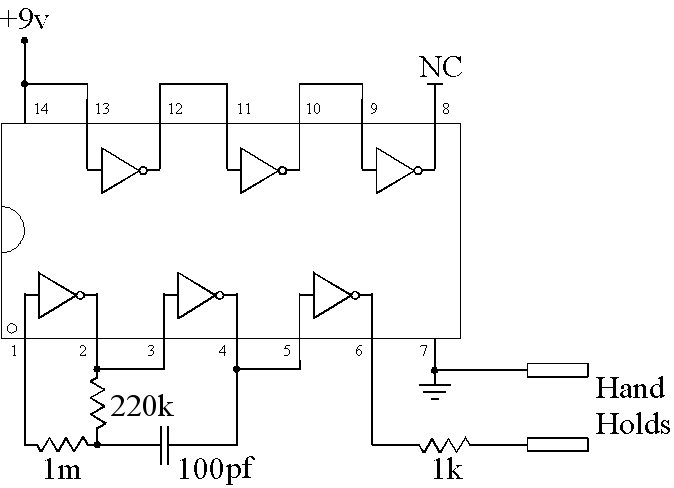Youtube Channel

FREE Hulda Clark Zapper Plans
FAQ
Plans
Parts and Materials
- A CD4069 hex inverter
(Digikey link)
- 1 1M resistor, 1 220k resistor, and 1 1k resistor
1M, 220k, 1k.
- 1 100pf capacitor
(Digikey link)
The Zapper is a very low power device so
1/4 watt resistors and 25 volt capacitors will be plenty sufficient,
but feel free to use whatever you find handy.
NOTE: The exact values of most components may be substituted
according to what you have on hand. The 220k resistor and the 100pf capacitor
determine the frequency of the Zapper, which may be allowed to vary pretty widely
according to Dr. Clark. The 1M should be kept relatively large compared to the 220K
to provide a reasonably symmetric waveform. The 1k should be kept within
10 or 20 percent of value to provide reasonable current limiting. (If you know what you are doing and
want to try different output currents, you can adjust this accordingly.)
(Click here for more information on varying the frequency)
The following parts may be substituted according to your preference, though
something of the kind will be needed:
- Solderless breadboard (Amazon link)
- 9-volt battery
- 4 alligator clip-lead sets
Radio Shack link
- 2 pieces of copper pipe (hand-holds)
* Sorry, Radio Shack appears to have changed their linking structure and their links don't seem to be working correctly. If you search around their site a bit you should be able to locate the necessary components. I'll try to post some alternate links when I get a chance.
Instructions
Plug the components into the solderless breadboard according to the schematic. Make sure none of the wires touch each other. Connect pin 14 of the chip to the positive terminal on the battery and pin 7 to the negative terminal, using clip leads or other suitable connectors. The two hand-holds are attached with another two clip leads. (One goes to ground on pin 7, the other to the loose end of the 1k resistor.)
Schematic Click Here to see Schematic in separate window

The above instructions are clearly not the only way you can do it. You can, for example, solder all the components directly onto a 14-pin socket or onto a piece of electronic perf board, like we do in our ready made version. This is a lot more time-consuming and difficult for most people, which is why we recommend a breadboard. As mentioned above, the resistors and capacitor don't all have to be the exact values mentioned here to make a working Zapper. However, any variation in capacitance or resistance will affect the output frequency. (There are limits on frequency and power consumption that the chip can handle, so don't stray too far from the specified values.)
If you have access to an oscilloscope you can use it to check your Zapper output when you are finished.
Home FAQ Plans Privacy